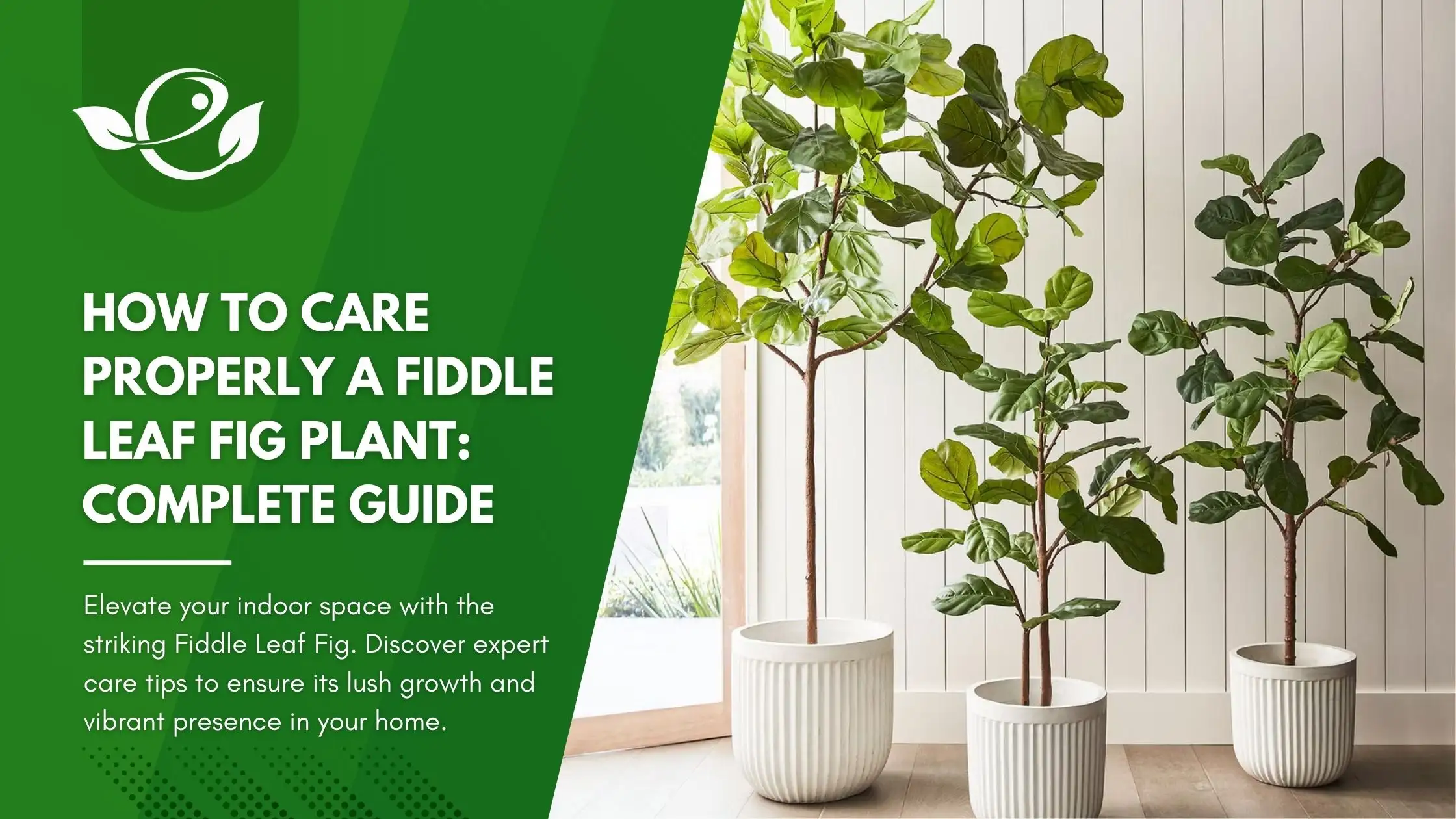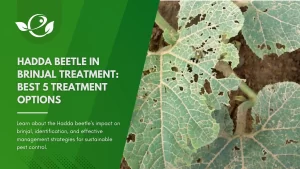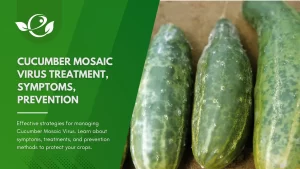Table of Contents
The Fiddle Leaf Fig (Ficus lyrata) has become a modern icon in interior design, celebrated for its bold, violin-shaped leaves and dramatic presence. While these plants are prized for their aesthetic appeal and natural air-purifying qualities, they also come with specific care requirements that can challenge both beginners and experienced plant parents. This expert guide dives deep into every aspect of fiddle leaf fig care—from the ideal growing environment to troubleshooting common problems—helping you nurture a thriving, statement-making houseplant.
Understanding the Fiddle Leaf Fig
What Is a Fiddle Leaf Fig?
The fiddle leaf fig, botanically known as Ficus lyrata, is native to the tropical rainforests of western and central Africa. With its broad, glossy leaves that resemble a fiddle or lyre, this tropical evergreen quickly became a favorite in urban homes. Despite its striking beauty, the fiddle leaf fig can be finicky, requiring careful attention to light, water, and environmental conditions to flourish.
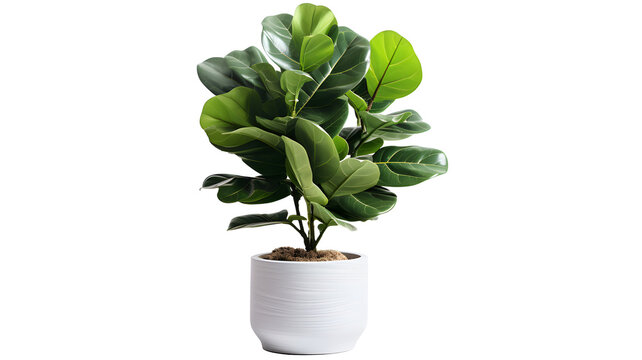
Key Details
| Attribute | Description |
|---|---|
| Common Name | Fiddle Leaf Fig, Banjo Fig, Lyre Leaf Fig |
| Botanical Name | Ficus lyrata |
| Family | Moraceae (Fig and Mulberry family) |
| Plant Type | Broadleaf evergreen tree/shrub |
| Height (Indoors) | Typically 6–10 feet (varies with care and growing conditions) |
| Height (Outdoors) | Can reach up to 50 feet in optimal outdoor tropical conditions |
| Native Range | Western and Central Africa |
| Hardiness Zones | USDA Zones 10–12 |
| Light Requirement | Prefers bright, indirect light (can tolerate lower light with slower growth) |
| Soil pH | 6 to 7 |
| Watering Needs | Requires moderate watering; water when the top inch of soil is dry to avoid over- or underwatering |
| Humidity | Thrives in moderate to high humidity; benefit from occasional misting or use of a humidifier in dry climates |
Benefits of Growing Fiddle Leaf Fig Plant
- Striking Aesthetic Appeal: Adds a bold, modern focal point with its large, sculptural, and violin-shaped leaves. Complements various interior design styles from minimalist to contemporary.
- Air-Purifying Properties: Contributes to improved indoor air quality by filtering out toxins and releasing oxygen. Creates a fresher and healthier living environment.
- Mood Enhancement and Stress Reduction: The vibrant greenery of a Fiddle Leaf Fig can boost your mood and add a calming, natural ambiance. Research suggests that interacting with indoor plants has positive psychological benefits.
- Versatile and Adaptable: Thrives as an indoor plant under the right conditions, making it suitable for urban apartments and homes. Can be used in various container styles, allowing you to match your décor preferences.
- Long-Lasting Statement Piece: With consistent care, it grows into a long-lived, impressive tree that can become a cherished part of your home. Its presence signals a healthy, well-curated space, enhancing overall interior aesthetics.
- Potential Air Quality Improvement: Along with purifying the air, the natural greenery contributes to a pleasant, inviting atmosphere that encourages productivity and relaxation.

Popular Fiddle Leaf Fig Plant Varieties
1. Standard Fiddle Leaf Fig
The classic fiddle leaf fig is what you typically encounter in nurseries and garden centers. It features large, glossy, violin- or lyre-shaped leaves and, when properly cared for indoors, can grow between 6 to 10 feet tall. This variety serves as an eye-catching focal point and is prized for its dramatic, sculptural form.
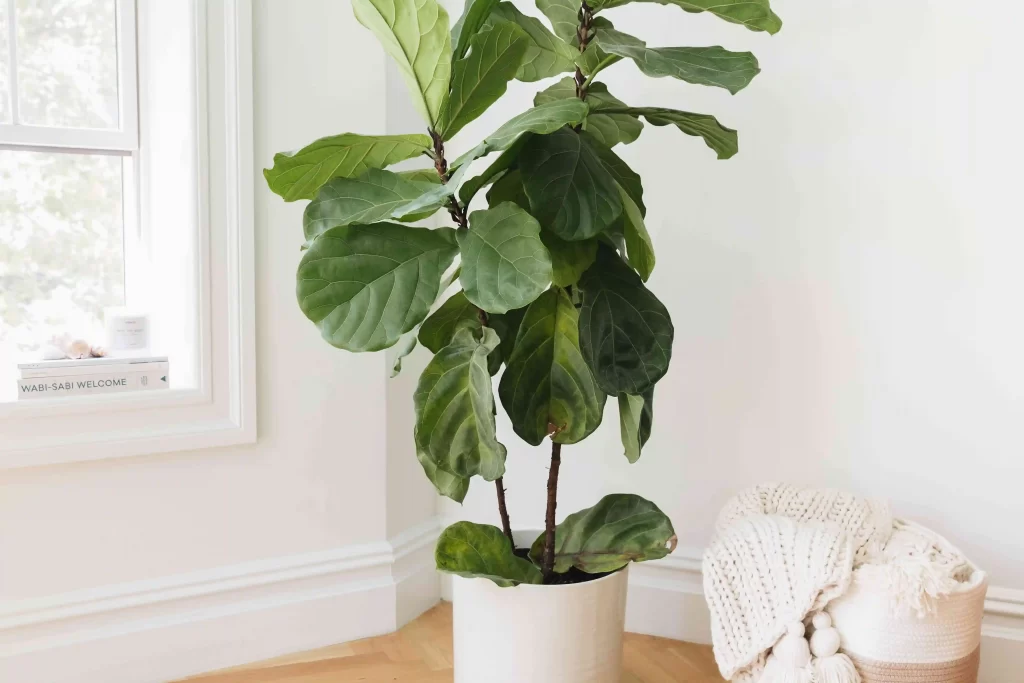
2. Ficus lyrata ‘Bambino’
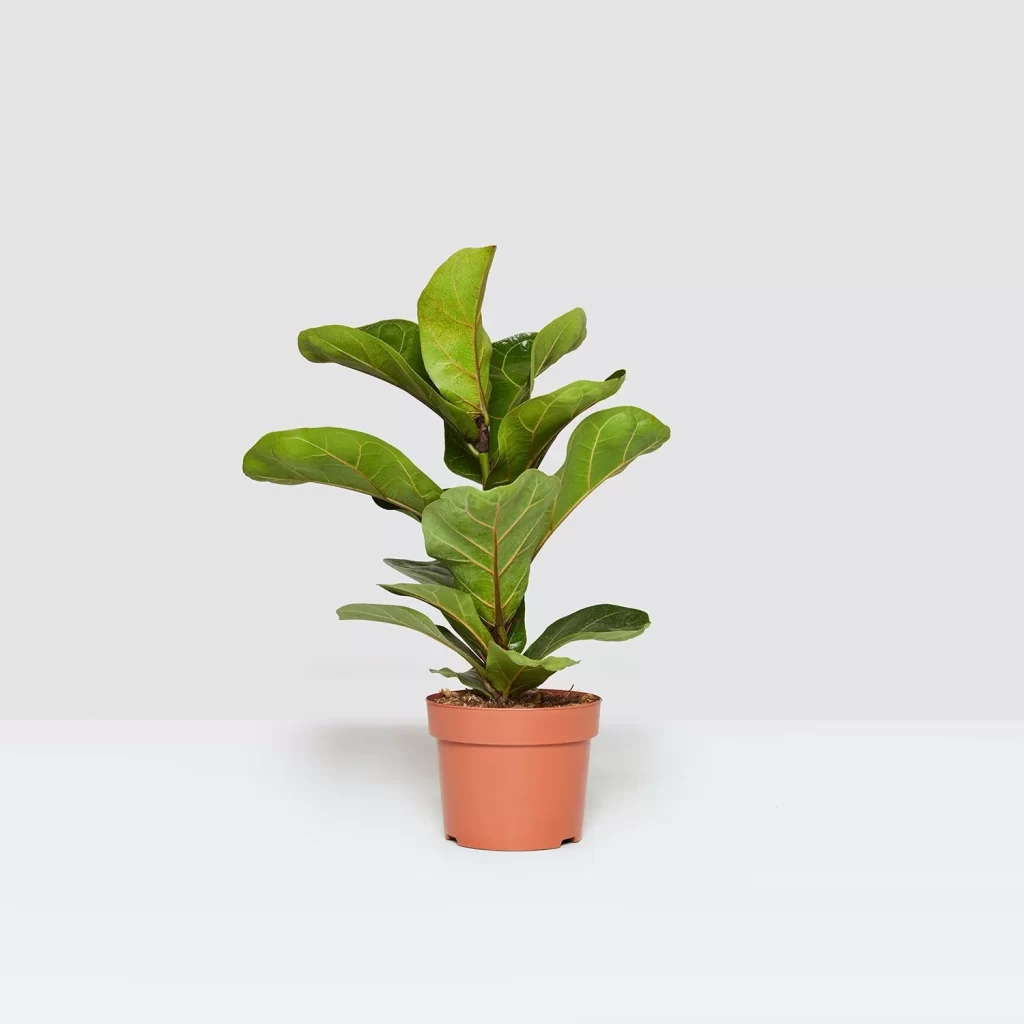
The Bambino is a dwarf cultivar of the fiddle leaf fig, ideal for smaller spaces such as apartments, offices, or tabletops. Despite its compact size, it exhibits the same striking leaf shape as its larger cousin—just on a smaller scale. Its manageable height makes it a perfect option for those seeking a stylish plant without the space demands of the standard variety.
3. Ficus lyrata ‘Variegata’
The variegated fiddle leaf fig is one of the most sought-after and visually dynamic varieties. Its leaves display a striking mix of green and creamy or white patches. While this variety can be a stunner in any room, its variegated foliage often indicates a slightly higher care sensitivity. It may require more attention to light levels and watering consistency to prevent the variegation from fading.
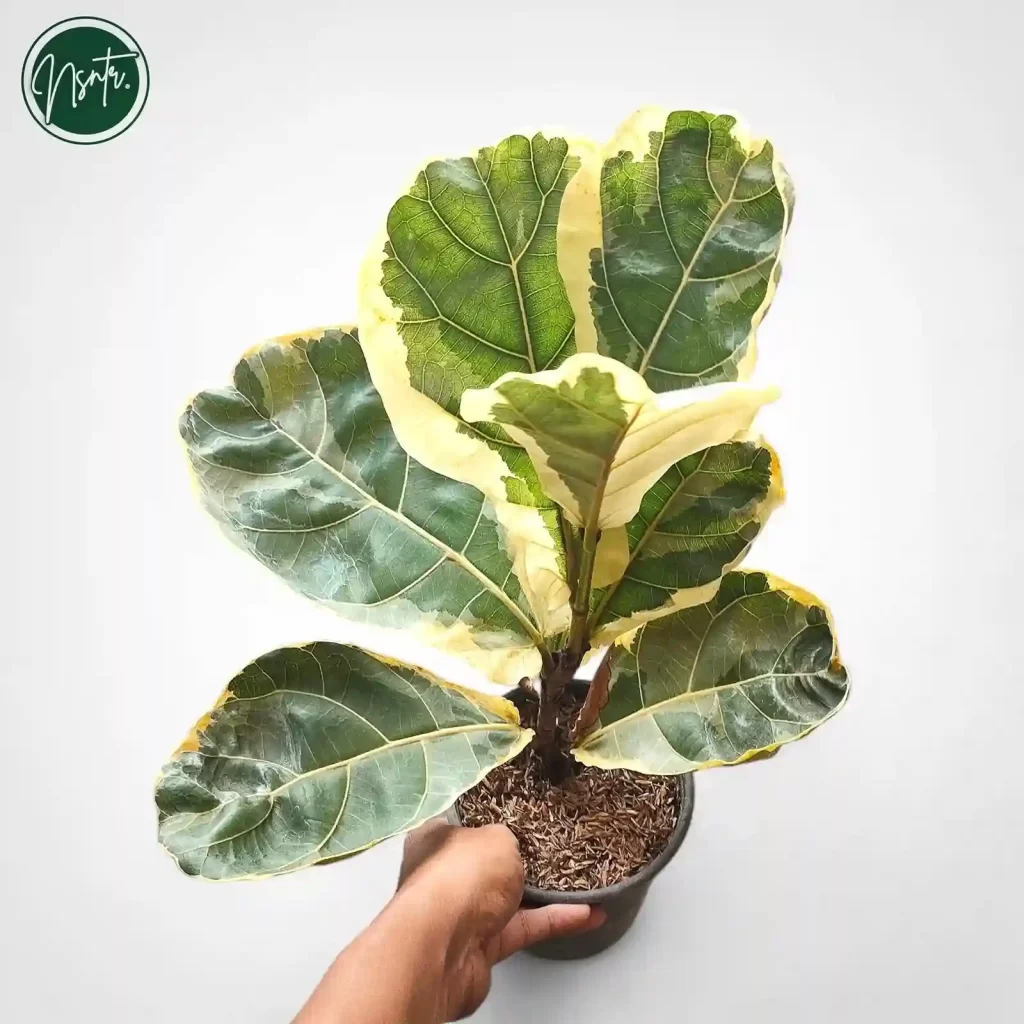
4. Ficus lyrata ‘Compacta’

Another popular cultivar is Ficus lyrata ‘Compacta’, sometimes referred to as the “short fiddle leaf fig.” This variety has a denser, more bushy habit and smaller leaves compared to the standard type, making it an excellent choice if you desire a fuller, yet more contained, plant. Its compact growth makes it well-suited to corner spaces and medium-sized rooms where a traditional tall fiddle leaf fig might overwhelm the setting.
Fiddle Leaf Fig Care
Light: How Much Sunlight Do Fiddle Leaf Figs Need
Fiddle leaf figs thrive on bright, indirect light. Aim to place your plant near an east- or southern-facing window where it can receive several hours of filtered sunlight without exposure to harsh, direct afternoon rays. If your space experiences intense direct sunlight, consider using sheer curtains to diffuse the light. Remember, insufficient light can slow growth and lead to leaf discoloration, while too much direct light can cause leaf scorch.
Temperature and Humidity
Maintain indoor temperatures between 60°F and 85°F to emulate the plant’s native tropical climate. These plants appreciate moderate to high humidity. In typical U.S. homes where air can be dry—especially during winter—boost humidity by misting the leaves, using a pebble tray, or placing a humidifier nearby. Aim for humidity between 30 and 65 percent. Place the plant away from cold drafts, heating vents, or air conditioning units. Sudden temperature changes can cause stress, leading to leaf drop or browning.
Choose the Right Pot and Soil for the Fiddle Leaf Fig
Always choose a pot with drainage holes to prevent water accumulation and root rot. The ideal pot should be only 2–3 inches larger in diameter than your plant’s root ball. Opt for a high-quality, well-draining potting mix. A blend that includes peat-based soil combined with perlite or cactus mix helps retain moisture without staying soggy. Consistent drainage is crucial for maintaining healthy roots.
Watering and Fertilization: Balancing Moisture and Nutrients
Water when the top inch of soil feels dry by using the finger test or a moisture meter. Both overwatering and underwatering can harm the plant. When you water, do so thoroughly. Allow water to run out of the drainage holes to ensure the entire root system is moistened. After watering, let the excess water drain completely. Empty saucers or trays beneath the pot promptly to avoid moisture buildup that leads to root rot.
During spring and summer, fertilize your fiddle leaf fig once a month using a balanced, high-nitrogen liquid fertilizer (e.g., one with an NPK ratio around 16-5-11). This promotes healthy leaf growth and strong roots. Avoid over-fertilizing; excessive nutrients or salts can damage the roots and create leggy growth. Every month, consider flushing the soil (by watering until excess water drains out) to remove any accumulated salts from fertilizers, especially if you use treated tap water.
How to Prune Fiddle Leaf Figs
Pruning is an essential part of maintaining a healthy Fiddle Leaf Fig. Not only does it help to remove any dead or damaged foliage, but it also encourages new growth and helps shape the plant into a more balanced, aesthetically pleasing form.
- When to Prune: The best time to prune is during the growing season, typically spring through early summer. This timing allows your fig to recover quickly and develop new growth as temperatures are more favorable.
- How to Prune:
- Use the Right Tools: Always use sharp, clean pruning shears to avoid crushing or damaging the stems. Wearing gloves is also recommended because the milky sap can be irritating to the skin.
- Selective Removal: Remove any wilted, yellowed, or damaged leaves, which not only improves the look of your plant but also reduces the risk of disease spreading. If the plant grows too tall or leggy, consider making a strategic cut just above a healthy leaf node to promote lateral branching.
- Technique: Make clean, angled cuts rather than ragged ones. This method helps the plant heal faster and minimizes the risk of infection. Avoid cutting too aggressively; generally, you should never remove more than 10% of the plant’s foliage at one time.
Additional Tips: When you cut, a white, milky sap is released. Wipe away the sap from your tools after each cut to prevent any potential spread of pathogens. After pruning, give your Fiddle Leaf Fig some time to adjust. If you notice excessive drooping or unexpected leaf drop, it might be a sign that the plant is temporarily stressed—a common response that usually resolves with proper care.
How to Propagate Fiddle Leaf Fig
Water Propagation
Water propagation is a beginner-friendly method. To start, select a healthy stem that has at least two to three nodes (the points on the stem where leaves and buds are attached) and remove any lower leaves that would be submerged. Dip the cut end in rooting hormone to encourage root development, then place the cutting in a clear container filled with room-temperature water. Position the container in bright, indirect light and change the water weekly. In about two to three weeks, you should notice roots beginning to form—once they reach about 1–2 inches, transplant the cutting to a small pot with a well-draining potting mix.
Soil Propagation
For soil propagation, follow a similar initial process: choose a healthy stem with sufficient nodes and trim it cleanly. Instead of placing it in water, dip the cutting in rooting hormone and plant it directly in a container filled with a moist, well-draining potting mix (a cactus or indoor plant mix works well). To maintain a humid environment around the cutting, lightly cover it with a plastic bag (vented to allow some airflow), and place it in a warm area with bright, indirect light. Check for root development after about three weeks by gently tugging on the cutting. Once you feel resistance, the cutting has likely developed enough roots to continue growing on its own.
Tips for Successful Propagation: Always use clean, sharp pruning shears to reduce the risk of infection. Maintaining consistent humidity is key for both propagation methods; misting or using a small humidifier near the cutting can improve success rates. Fiddle Leaf Fig propagation may take several weeks before roots are established, so be patient and maintain consistent care throughout the process.
Potting and Repotting Fiddle Leaf Fig

When you first bring your Fiddle Leaf Fig home, it’s crucial to give it a good start in an appropriate pot. Here are some key points to consider:
- Choosing the Right Pot: Select a container that has proper drainage holes to prevent water from accumulating. A pot that is just 2–3 inches larger in diameter than the root ball is ideal. This helps avoid excessive soil moisture, which can lead to root rot.
- Soil Selection: Use a well-draining potting mix for indoor plants. A blend containing peat (or coco coir), perlite, and a small amount of compost ensures that the soil holds just enough moisture while allowing excess water to flow out freely. Good drainage is essential for the overall health of your Fiddle Leaf Fig.
- Initial Potting Process: Place a layer of fresh potting soil at the bottom of the pot. Gently set your Fiddle Leaf Fig in the center and fill around the roots with more soil, firming it lightly with your hands. Avoid packing the soil too tightly; the roots need space to breathe and expand. Water thoroughly so that the soil settles evenly and excess water drains out, demonstrating that your drainage system is effective.
As your Fiddle Leaf Fig grows, repotting becomes an important step to sustain vigorous growth:
- When to Repot: Young plants are generally repotted annually in the spring, while mature plants might need repotting every 18–24 months. Signs that repotting is needed include roots growing out of the drainage holes or water running freely through the soil, indicating a crowded root system.
- Repotting Technique: Gently remove the plant from its current pot while protecting the root ball. You can lightly tease the roots if they’re densely matted. Choose a new pot that is just slightly larger than the current one to prevent overwatering. Place a layer of fresh, well-draining soil at the bottom of the new container, and reposition your plant in the center. Fill with soil around the roots, ensuring there are no large air pockets. Water the plant thoroughly afterward to help settle the soil and reduce transplant shock.
Troubleshooting Common Fiddle Leaf Fig Issues
Bleached Leaves
Exposure to harsh, direct sunlight—especially during the hottest part of the day—can cause the leaves to lose their vibrant green color. A sudden increase in light intensity, perhaps due to an abrupt change in location or window exposure, may overwhelm the plant.
What to Do: Place the plant in an area where it receives bright, filtered light instead of direct, intense sun. An east- or north-facing window or the use of sheer curtains can help diffuse harsh light. When moving your plant to a brighter spot, acclimate it slowly over several weeks. Gradually increase the duration of sunlight exposure rather than making a sudden change.
Brown Spots on Leaves
Excess moisture trapped in the soil restricts oxygen flow to the roots, leading to decay that manifests as brown, necrotic patches. Pathogens often invade weakened tissue, causing localized brown discoloration. Sudden cold drafts or fluctuations in temperature also may damage tissues and result in browning.
What to Do: Increasing the airflow around the plant can help reduce fungal or bacterial growth. In some cases, using a natural fungicide or diluted neem oil spray may help control pathogen spread. Check that you’re allowing the top inch of soil to dry out between waterings and ensure that your container has proper drainage to prevent waterlogging. Carefully remove any leaves that exhibit severe browning to limit the spread of potential rot or disease. Discard pruned material to prevent reinfection.
Yellowing Leaves
A lack of essential nutrients—such as nitrogen or phosphorous—can cause new growth to appear yellow or pale. Both underwatering and watering inconsistently can stress the plant, resulting in yellowing leaves. In some cases, the early signs of infection may appear as yellowing before progressing to browning.
What to Do: Consider a balanced, diluted fertilizer during the growing season to provide necessary nutrients. Avoid over-fertilization, which can lead to salt accumulation. Maintain a consistent watering routine, ensuring the soil dries moderately between waterings. If yellowing is accompanied by other signs of stress, inspect the plant for pests that might be transferring disease.
Dropping Leaves
Changes in location, light, or temperature can stress the plant, causing temporary leaf drop. Both overwatering and underwatering can lead to significant leaf drop. Repotting or poor soil conditions might temporarily shock the plant, leading to shedding.
What to Do: Once you’ve chosen a suitable, stable spot, avoid moving the plant frequently. Use a moisture meter or the finger test to check soil dryness before watering and avoid letting the plant sit in puddles after watering. Mild leaf drop may be normal as the plant adjusts. Continue your care routine and monitor for new growth as signs of recovery.
Black Spots on Leaves
When the roots are too saturated for prolonged periods, toxins can build up, leading to black discoloration. Some pests may cause localized necrosis or introduce harmful pathogens that result in black spots. Infections can sometimes progress quickly, leaving distinct dark lesions on leaves.
What to Do: Examine the soil and roots for signs of overwatering. If rot is suspected, remove the plant from its container, trim away affected roots, and repot in fresh, well-draining soil. Use an appropriate pesticide or neem oil treatment after isolating and pruning infected parts. Ensure good air circulation and avoid water stagnation, as both help reduce the risk of infections.
Sunburn and Light Stress
Leaves can develop burned patches or crispy edges when exposed to intense, direct sunlight that their delicate tissues cannot tolerate. A sudden move from a low-light area to a high-intensity setting can shock the leaves.
What to Do: Use blinds or sheer curtains to diffuse direct sunlight, or relocate the plant to a zone with bright, indirect light. If transitioning to a brighter environment, gradually introduce the plant to higher light levels over several days.
Common Pests & Diseases
| Pest/Disease | Common Cause | Signs to Look For |
|---|---|---|
| Spider Mites | Dry indoor environments; low humidity levels. | Fine webbing on leaf undersides; stippled or discolored leaves; leaf drop in severe cases. |
| Mealybugs | Introduction from infested plants; warm, moist conditions. | White, cotton-like masses on leaves and stems; sticky honeydew secretion; sooty mold development. |
| Scale Insects | High moisture levels, contaminated tools or hands, or wounds on the plant. | Small, round, brown or white bumps on leaves, stems, or trunk; yellowing leaves; leaf drop; sticky honeydew on plant surfaces. |
| Fungal Infections | Poor air circulation, high humidity, and contact with infested plants. | Brown or black spots on leaves; leaf wilting; root rot symptoms; mold growth on soil surface. |
| Bacterial Infections | High moisture levels, contaminated tools or hands, wounds on the plant. | Light brown spots with irregular edges; multiple spots on a single leaf; newer leaves more affected; spots may ooze or have a yellow halo |
Final Thoughts
Fiddle Leaf Fig care does not have to be daunting. By understanding the specific needs of your plant—ranging from proper light, temperature, and humidity to water, soil, and nutrition—you can create an environment in which your fiddle leaf fig not only survives but thrives. Consistency is key: establish a maintenance routine, monitor your plant’s condition closely, and make adjustments promptly when issues arise.
With the comprehensive tips and expert guidance provided above, you now have everything you need to transform your fiddle leaf fig into a magnificent, statement-making centerpiece. Enjoy the journey of nurturing your plant and feel free to share your experiences, ask questions in the comments, and join the thriving community of fiddle leaf fig enthusiasts.
